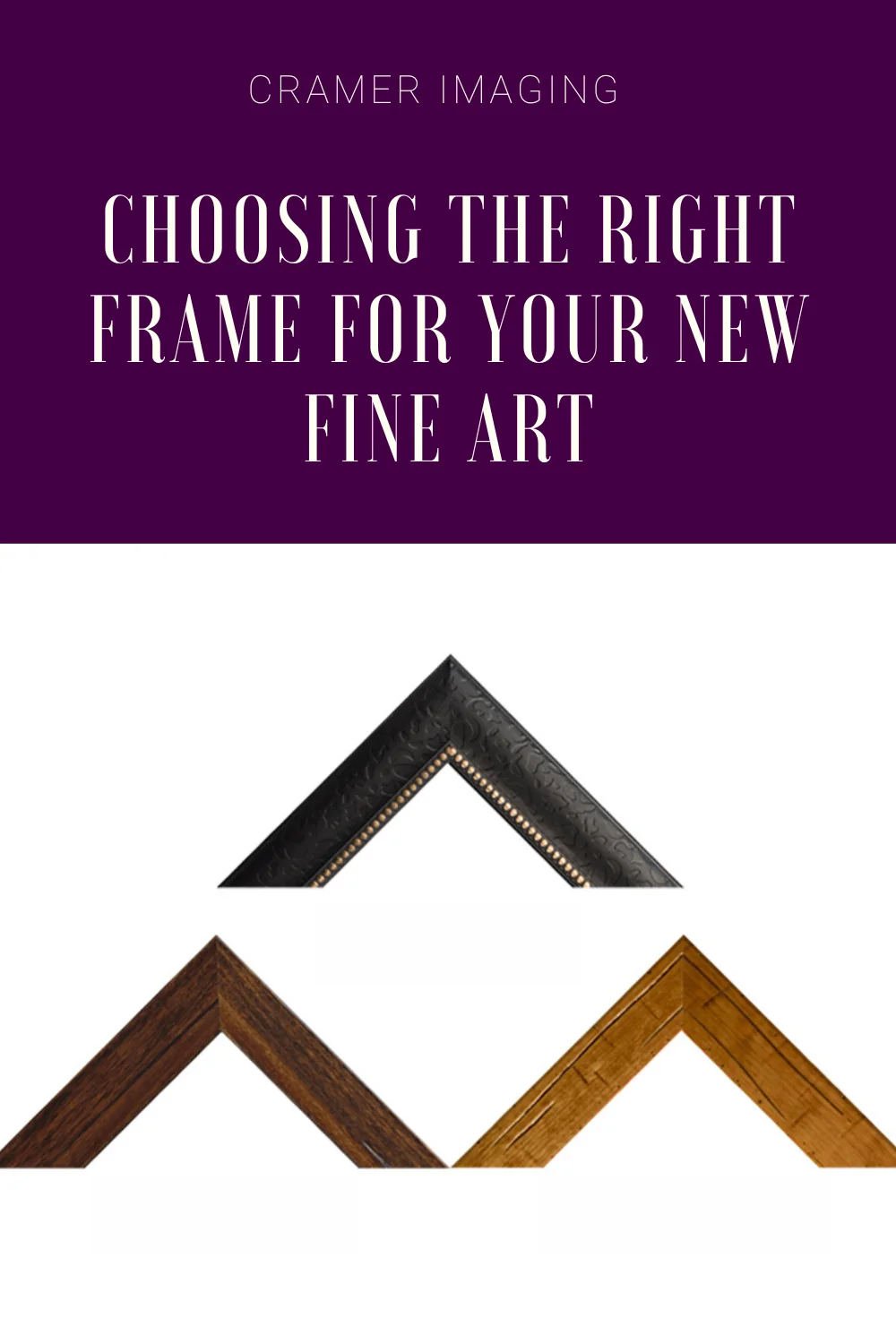Choosing the Right Frame for Your New Fine Art
Shop

Choosing the right frame for your wall art is an important part of decorating your house. You can really accent the best fine art perfectly by the right choice of frame as can much of the surrounding decor. How do you know that you have chosen the right frame for your artwork? Here are a few tips on how to select a frame.
Preliminaries
We often consider framed art as the focal point of most home decor. It is a statement piece with huge impact on any guest viewing it. When shopping for a new frame, you might find it easy and tempting to just get any old frame in the hopes of saving time and effort. If you invest more time in your selection process, your artwork will have a maximum impact which you cannot get with cheap and generic frames. However, to create that maximum impact, there are a few questions you must answer about your choice of frames.
First, do you even want a frame for your wall art? An unframed gallery wrap or a metal print (which generally does not go in a frame) can make highly attractive alternatives for a modern home decoration scheme. Of course, you may not be going for that particular look in your home. This is a decision only you can make for yourself and your home.

Next, do you want to frame the art by itself or would you rather mat the art and then frame it? If you choose to frame the art by itself, then you only need to worry about the outside dimensions of the artwork when choosing your frame. If you want to mat the art, then you need to worry about getting the correct outside dimensions of the mat you are using when choosing the right frame. For more on properly matting your fine artwork, see this article from last week.
Finally, can your wall support the weight of the frame you choose in addition to the artwork inside? You don’t want to damage or destroy an expensive piece of art because the wall was too weak to support it. This is not a problem for most small and light frames but can be problematic for the larger and more ornate frames. They come with a greater weight load. If you’re not sure the wall will support the weight, then don’t get something heavy.
If you have decided that framed fine art is the way to go for you, then there are a few factors to consider when selecting the frame to house your picture.
Frame Size
Perhaps the single most important factor to consider is the size of the frame. It must be big enough to hold the art and/or the mat which you will be displaying in it but not too big that the art will fall out. This is in reference to the inside dimensions of the frame.

Lots of artwork and mats come in standard sizes. This will make frame selection easy if you need a frame for a standard-sized picture. For a list of the standard sizes of picture frames commercially available today, check out this article. If you have chosen a piece of art which does not meet those standard dimensions (panoramas are one such example), you can mat it in order to make it standard sized or you can seek out a custom frame.
Most craft stores, art galleries, and art supply stores will offer custom matting and framing if you find that you need this particular service.
Frame Composition
When choosing the frame for your wall art, you will have a few options for the composition of the frame or what it is made out of. These include wood, metal, and plastic. You will need to consider the rest of your home decorations which will be right next to this frame. Will the frame work with those decorations or will it clash in a bad way?
Wood Frames
Wood frames are among the most commonly available frames out there on the market. They are versatile and classic. They come in lots of different colors and can be painted or stained for emphasis on the wood grain. Again, they can be simply made or very ornate depending upon your budget. The more ornate ones can also be some of the heaviest frames out there for the larger pieces of art so bear this in mind when shopping for a large frame. If they scratch, chip, or crack, there is no fixing that which will hide from a close inspection.

Metal Frames
Metal frames are also quite common. You see them most in the smaller standard sized frames on the market. They are modern and sleek in look. They are also thin and tend to emphasize the picture itself rather than add something to it. This thin nature tends to mean that they easily bend and break if misshapen too much. Metal frames can be any color but are most often gold or silver tone and highly reflective. This can be a blinding problem for people if the art is to be hung in a place which receives direct sunlight. If the finish flakes off, it can be a noticeable distraction from the artwork itself.

Plastic Frames
The last kind of frame commonly available is the plastic frame. They are cheap and versatile. You are also reasonably guaranteed that there will not be any flaws in the plastic as you can get in both metal and wood. They can be made in any shape and color you want. They can be as simple or ornate as you want. Also, they can also be a lighter alternative to wood if the wall might not hold a wooden frame. They also hold all the inherent flaws of plastic: they fade, they become brittle over time and sunlight exposure, they can look cheap, etc.

Frame Color
The next consideration is what color your new picture frame will be. In choosing the right picture frame, you must address color. There are tons of choices out there on the market in every shade and hue you can imagine. You have the brights, the pastels, the muted, the mixed, the darks, the neutrals, and more in every color of the rainbow and then some.
When you break it down, you have the exact same options as you do with mat board. You can run with a blending, neutral, or contrasting color for your picture frame. You can read last week’s article segment on mat colors for more details about the schools of thought connected with each color family choice.
Something to consider, while mats are to help frame the fine art but not overshadow or detract from it, frames have a slightly different purpose. True they are to frame the piece. But they can also add some accent and contrast too. It’s highly popular in the fine art world, for example, to frame a piece with a white mat and a thin black frame. This provides both neutrality and contrast to let you know where the image ends.

Also keep in mind that the frame you choose should complement the artwork it houses and should fit in with the room decor it is displayed in. A frame of a particular color may look amazing when paired with a piece of art and a mat but look terrible when added to the rest of the decorations in the room it’s displayed in. Choose your frame carefully for this reason.
For a good general piece of advice on choosing the right frame color, pick something neutral. This means choosing one of the three neutral colors or one of the several pseudo-neutrals out there. Your neutrals are white, black, and grey. Your pseudo-neutrals include off-white, tan, brown, beige, navy blue, and silver. Any of these colors will work with most home decoration schemes and color palettes.
Frame Styling
Your final selection criteria is your picture frame styling or, in other words, how simple or ornate your frame is. Frames need not be flat and boring in order to accent the artwork within.
I’ve seen some frames which are strictly a block of wood set up in the correct dimensions of a frame along with some wood staining and that’s it. Your fine art frame can be just that simple.

On the other hand, I have seen frames which are works of art all on their own. They are large and in charge with layers of intricate beveling and detail work on a thick chunk of wood. Really and truly, these kinds of frames are their own work of art. You’ll find this kind of frame better suited for the larger pieces of fine art like 20×30 inches and larger. The bigger the better with these kinds of frames.

Most mid-size and small frames come with some amount of beveling, though not as ornate or intricate as the largest frames out there. You can even find some other pseudo-detail work in plastic frames in this size group. You have plastic molds to thank for that fact.
Whatever styling you choose for your frame, make sure it won’t overpower the art you want it to contain. After all, supposedly the feature is the artwork not the frame housing it. If the frame adds something to the overall look without distracting you from the inside contents, then you probably have a winner.
Cramer Imaging’s Framing Options
If you’re choosing the right frame for your Cramer Imaging fine art, we’ve got you covered. We offer some different framing options which you can choose from. See below for examples.

Conclusion
Choosing the right frame for your new fine art is simply a matter of getting the right size, composition, color, and styling. With all of these elements combined, you will have a perfect frame to display a beautiful work of art with. Your next challenge will be hanging it up on the wall. Next week, we will be discussing methods of hanging a picture frame on the wall and keeping it up there.
Best Sellers
Cramer Imaging Newsletter

Receive monthly updates in your inbox from us.













